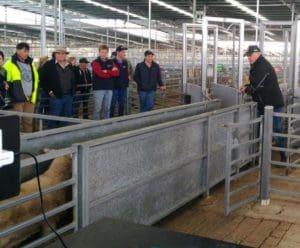
Lanyons auctioneer Warren Clark drafting lambs into the EID scanners at Hamilton.
HAMILTON’S sheep and lamb saleyard will be the first major centre to gain State Government funding approval for electronic tag scanning equipment and software, to upload data to the National Livestock Identification System.
The Andrews Labor Government will provide $460,000 for the Hamilton Regional Livestock Exchange to install new state-of-the-art laneway and draft readers, and recently updated software and data logging equipment, to boost traceability and efficiency.
Minister for Agriculture Jaala Pulford announced the major grant yesterday as part of the transition package to support the mandatory uptake of EID of all sheep and goats in the state. The planning and design phase for the new infrastructure was also supported by the transition package.
Hamilton is one of 22 Victorian saleyards that submitted applications for electronic identification infrastructure funding to Agriculture Victoria by the closing date of October 31 2017. Victorian saleyards must scan and upload data for all electronically tagged sheep from March 31 2018.
In September this year, livestock technology company Aleis successfully demonstrated its newly-developed Hamilton draft reader and wireless synchronisation technology, reportedly achieving 100 percent read rates and accurate pen allocation out of a three-way draft without interrupting sheep flow. Various readers were wireless synchronised in the Agriculture Victoria trial.
As per the Agriculture Victoria funding agreement, tender and procurement procedures, and final council approval, scanning equipment and software is expected to be installed at Hamilton
The Hamilton EID system is expected to involve mainly post-draft pre-sale laneway scanners, supplemented by hand scanners when necessary.
“It will be just one scan at the draft, with some hand scanning for little lots,” Mr Dahlenburg said.
“It will sort of work itself out as it goes along, I think.”
Similar post-draft scanning equipment and technology is also expected to be installed at the Horsham and Bendigo saleyards.
Hamilton saleyard manager Chris Dahlenburg said the saleyard has yarded about one million sheep and lambs annually for the past 5-6 years. He hoped the centre would be ready to scan and upload sheep and lamb EID data by March 31 next year.
“We are working towards that.”
Mr Dahlenburg said the September trials demonstrated that sheep and lambs can be scanned through the saleyards.
“When we get to 60,000 lambs, it is going to be a new challenge.”
Hamilton’s proposed system was submitted for funding under the Labor Government’s electronic identification transition package following extensive consultation with local agents, transporters and saleyard staff, and with assistance from a specialist contractor.
Ms Pulford said Victoria is leading the way with the game-changing technology.
“We’re getting it done – helping protect Victoria’s sheep and goat industries and our crucial access to important export markets.
“Everyone involved with the Hamilton submission should be congratulated on the collaborative effort that went into an effective scanning solution for this major and complex facility,” she said.
“We said from the very beginning we wouldn’t let the industry absorb these system changes alone.
“It’s why we’ve worked collaboratively with the industry, including our saleyards, to make sure these grants are indeed available.”

‘It will sort of work itself out as it goes along, I think’. I can not believe the incompetence of the Victorian Government to throw millions of taxpayers dollars at a scheme that has already been trialled on the Australian cattle herd and found not to be working.
A large cattle producer rang me recently. The family run 70,000 cattle across a number of properties. Their current tag loss rate is running at 52 percent for calves that were tagged at branding to selling them at 8-10 years old. Had lunch with another producer that underwent an EU audit recently. The database claimed that they had 9000 cattle on their account when in reality they only had 4200 on their property.
Cattle Producers have spent over a billion dollars on NLIS, while countries without RFID NLIS are taking our market share. RFID NLIS was not a requirement for EU entry by Brussels, it was made a requirement by Cattle Council. The irony is that we import more meat from the EU than we export. Victoria is isolating itself as a high-cost lamb producer with the claims made for RFID by their Minister for Agriculture — laughable.